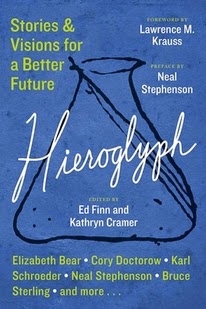
Yesterday I ran over and picked up my copy of the new science fiction anthology Hieroglyph from the independent bookstore Politics & Prose. (Short run–it’s only about a mile from my house.) Hieroglyph was inspired by a challenge that Michael Crow, president of Arizona State University (ASU), issued to science fiction author Neal Stephenson at a panel convened by ASU’s Future Tense partnership in 2011. They began talking about why so much science fiction focuses on the dark side of potential futures and, as Stephenson tells the story, Crow “basically told me that I needed to get off my duff and start writing science fiction in a more constructive and optimistic vein.”
Hieroglyph was inspired by a challenge that Michael Crow, president of Arizona State University (ASU), issued to science fiction author Neal Stephenson at a panel convened by ASU’s Future Tense partnership in 2011. They began talking about why so much science fiction focuses on the dark side of potential futures and, as Stephenson tells the story, Crow “basically told me that I needed to get off my duff and start writing science fiction in a more constructive and optimistic vein.”
One result of that conversation is Hieroglyph–a collection of science fiction that envisions future scenarios that might inspire us to make these visions come true: Not just functional medical tricorders or quantum teleportation systems (though those things are pretty neat) but social and political structures needed for a better and more equitable world. Today on Future Tense blog, Joey Eschrich introduces Hieroglyph and makes the case that the cultural aspects of scifi are cooler and more important than the gadgets.
Eschrich reminds us that Michel Foucault defined technology as encompassing structures, systems of thought, and processes, not just physical items. The biggest disruption taking place in K-12 education, for example, isn’t MOOCs or tablets or data analytics, it the realization that we need to move from an “assembly line” approach that treats students as interchangeable widgets and content as something that can be segregated into separate classes, to a technology of personalized, blended learning. The structure, culture and processes of education need to change–though these changes will indubitably be supported by the gadgets at our disposal.
Eschrich nails it when he says “the most important innovations that will shape our future are… the beliefs, values, communities, and relationships that will determine how we use them.” The current surge in crowdsourced museum projects is driven by the ability of the web to recruit the assistance of strangers, but more fundamentally it reveals the the desire of the public to be invited to contribute to our work, and cultivates the expectation that we provide opportunities for them to do so. Wikipedia, blogs, Facebook, Twitter are supported by (electronic) technologies, but by empowering anyone to be an author, and editor, they reshape public attitudes towards authority and overturn the culture and economy of traditional publishing. E-retailers like Amazon now account for nearly half of all book sales. In the past 20 years, there has been a 50% decrease in the number of independent bookstores in the US. Do I like the prospect of a future devoid of quirky, personalized neighborhood book dives? No. That’s why I ordered Hieroglyph through Politics & Prose –paying over a third more than I would have via Amazon. While I appreciate the fact that technology can make goods like books more available and affordable to many people, I’m willing to pay a premium to invest in the future of my neighborhood.
Your Futurist Friday assignment, with several options for upgrades:
- Reach Escherich’s article, and think about the most memorable science fiction you have read, watched or listened to. Beyond the gadgets, how is the world it depicts fundamentally different from the present?
- Check out the Future Tense project (a collaboration of ASU, New America and Slate), sign up for their newsletter and follow the Future Tense blog on Slate. They do good work.
- Get a copy of Hieroglyph and dive in. If you want to discuss the stories, we can use the comments section below, to trade notes.








Comments